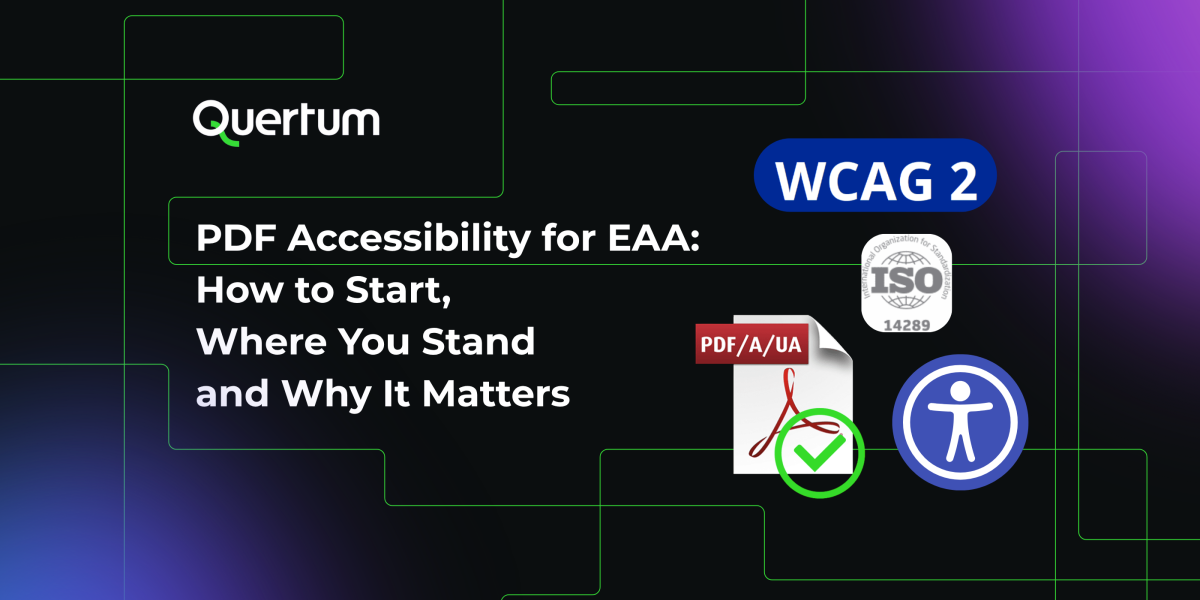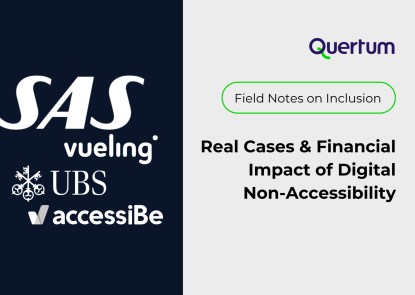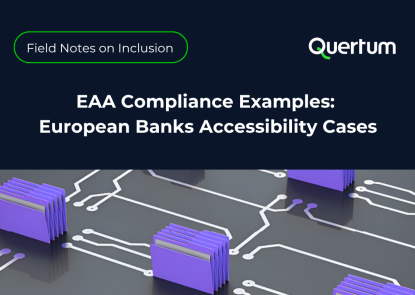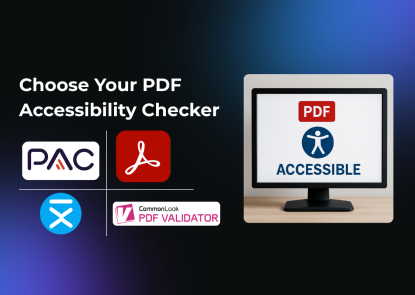PDF Accessibility and EAA: Guide for Compliance
June 2, 2025

We rarely stop to think about how seamless our digital lives are. But with the PDF Accessibility and European Accessibility Act (EAA) deadline approaching in June 2025, organisations must act now to ensure digital equality — and legal compliance.
We scroll, shop, book, and bank without ever questioning whether the platforms we use are built for us. For the roughly 80 million Europeans living with a disability, though, the digital experience often looks very different, marked by limitations or outright exclusion.
That’s where the European Accessibility Act (EAA) comes in. From 28 June 2025, businesses offering digital services or selling certain products in the EU will need to meet strict accessibility standards. It’s a major step toward creating a more inclusive digital economy, and it’s going to impact everything — e-commerce platforms, e-books, insurance documents, ticket machines, shopping platforms, banking statements and apps. You can read more on our previous blog about how enterprises are preparing to EAA in different European countries.
The directive has been in motion for years, but many organisations still haven’t taken real steps to prepare. Meanwhile, industry leaders are quietly doing the work and positioning themselves to gain compliance and a competitive edge.
If you’re not there yet, you’re not alone. However, you are now at a decision point – move forward or fall further behind?
All Starts from Growth Mindset
There’s a tendency to frame accessibility in regulatory terms, as a box to tick, a deadline to meet, or a risk to avoid. Yet, for businesses that want to squeeze more from opportunity and lead, not just comply, the EAA offers something far more valuable. Namely, a clear reason to improve the user experience for everyone.
Early adopters are already seeing the benefits. Some retailers, for instance, report up to a 35% increase in conversions after making their digital platforms more accessible. That’s because accessibility improvements often go hand-in-hand with better usability – not just for people with disabilities, but for everyone. We’re talking about cleaner interfaces, clearer navigation, consistent content structures, features that make digital experiences more intuitive. They reduce friction, spark innovation, build trust, and keep customers coming back.
Essentially, being EAA-ready doesn’t only protect you from fines and sanctions, it also positions you as a business that understands where the market is going – and is prepared to lead in the right direction.
First Steps to Get Accessibility
So what does it look like to get serious about accessibility when you may be starting a little later than others?
The first step is very simple: figure out where you stand. That means inspecting your website, apps, service platforms and internal tools, not merely for obvious issues like missing alt texts or contrast failures, but for structural barriers that affect real user journeys.
- Can a customer complete a purchase without using a mouse?
- Is your chatbot accessible by screen reader?
- Do your mobile experiences meet the same standards as desktop?
Of course, these aren’t questions for a single compliance officer to answer. Accessibility touches product, design, development, customer service, and legal operations, which means it has become a shared priority, not a siloed task.
Don’t know where to start EAA preparations? For the first touchpoint, you can download our WCAG 2.1 and PDF Accessibility guides for free (no email address is required). Those guides are created for:
- Better understanding of your PDF/UA and WCAG compliance situation
- What makes PDF documents and site accessible
- Understanding on how to fix first accessibility red flags.
These guides could be your roadmap to EAA preparations and how to be compliant with PDF/UA (ISO 14289), EN 301 549, and WCAG 2.1. By the way, both of those PDFs are accessible and PDF/UA compliant 🙂
Closing the Gap Without Falling Behind
When time is short and pressure is high, it’s tempting to search for shortcuts. But accessibility isn’t something you can just add on at the end of the process. Real progress means building a roadmap that accounts for both short-term fixes and long-term change.
Yes, some updates are straightforward: adjusting colors, labelling buttons, adding keyboard support. These can and should be addressed quickly. However, other work, such as redesigning navigation flows, integrating with assistive tech, or rethinking your content strategy, takes more time, more collaboration, and more care.
This doesn’t have to mean halting business as usual – accessibility can be integrated into agile workflows and existing development cycles. In fact, some of the most effective efforts happen incrementally. The key is to start, and to treat accessibility not as a project with an end date, but as a part of how you build and maintain digital services going forward.
Don’t Stop on Alt Text Only
It’s easy to fall into the trap of performative accessibility, making a few quick, visible changes like adding alt text or tweaking colours, and assuming the job is done. However, real accessibility is more than mere appearances, it is also about outcomes: can users with diverse needs actually complete tasks, access information, and engage with your service without barriers?
While alternative text is an essential part of accessibility, it’s only one piece of the puzzle. A truly accessible PDF requires correct tagging structure, proper reading order, logical headings, usable tables, form field labelling, colour contrast checks, and more.
Passing an audit once doesn’t guarantee long-term compliance — especially under the European Accessibility Act, where consistency and future updates matter. That’s why accessibility must be systemic, not superficial.
The truth is, accessibility is only meaningful when it works for real people navigating real challenges. That means going beyond checklists to understand how users actually experience your site or service – and whether they’re truly able to use it.
Even a website that passes today’s audit may fail tomorrow if updates are made without accessibility in mind. Regular testing, feedback from users with disabilities, and iterative improvements are what separate superficial fixes from sustainable progress.
Additionally, there’s value in openness. Letting your customers know you’re working on accessibility, even if you’re not there yet, can earn you credibility. It signals that you care, that you’re listening, and that you’re committed to building a better digital experience.
Why PDF Accessibility Demands More Than Automation
Making your PDFs truly accessible isn’t as simple as running an auto-check or pressing a “Make Accessible” button in Adobe. While tools can help flag issues, they rarely deliver fully compliant, user-friendly results on their own — especially when it comes to complex layouts, interactive forms, or branded documents that rely heavily on custom styling.
The challenge? Maintaining visual consistency and brand integrity while ensuring that every element — from tables and infographics to reading order and form fields — works seamlessly with assistive technologies. Automated fixes often flatten design, strip meaning, or miss key accessibility gaps altogether. Worse, they can create a false sense of security while leaving you exposed to compliance risks.
This is not something most internal teams are equipped to handle alone — especially under time pressure. That’s why many organisations partner with accessibility experts who not only understand the technical requirements (PDF/UA, EN 301 549, WCAG 2.1), but also know how to preserve design and user experience throughout the process.
It’s Not Too Late, But It Is Time
This is your chance to step back and ask: How do users move through our services? Where do they get stuck, frustrated, or excluded? What would it look like to make every touchpoint intuitive, inclusive, and seamless?
Accessibility doesn’t sit in a vacuum. It intersects with your ESG goals, your DEI commitments, and your customer experience ambitions. Leading companies are already drawing these lines, and using them to futureproof their strategies.
So yes, the clock is ticking, but getting serious about accessibility now puts you in a position to lead, not scramble to catch up later.
Summary
With the European Accessibility Act deadline approaching on 28 June 2025, industry leaders are already working toward compliance and gaining a competitive edge in the process. However, even if you’re behind now, it’s not too late to start. Accessibility isn’t only about ticking boxes. Done well, it improves the experience for everyone, and early adopters are already seeing the benefits. The first step is understanding where you stand and recognising that accessibility touches every part of your organisation. It’s not a one-off project, but an ongoing commitment. Avoid the trap of quick fixes that don’t serve real users. Instead, use this moment to rethink how your digital experiences can be more inclusive and take the first step now.
Let’s drive your Digital Transformation Together.
Schedule a free consultation with our team to explore how we can help you achieve your goals.


